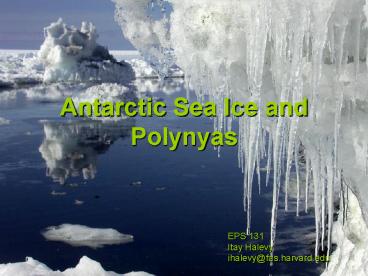Antarctic Sea Ice and Polynyas - PowerPoint PPT Presentation
1 / 22
Title:
Antarctic Sea Ice and Polynyas
Description:
Definition - any form of ice at sea that has originated from ... frazil. grease. nilas. pancake. Classification and Formation. Classification by age (thickness) ... – PowerPoint PPT presentation
Number of Views:149
Avg rating:3.0/5.0
Title: Antarctic Sea Ice and Polynyas
1
Antarctic Sea Ice and Polynyas
EPS 131 Itay Halevy ihalevy_at_fas.harvard.edu
2
Overview
- Antarctic Sea Ice
- Definition
- Classification and formation
- Extent and variability
- Observation
- Climatic significance
- Polynyas
- Definition
- Formation mechanisms
- Ecological and climatic significance
3
Antarctic Sea Ice
- Definition - any form of ice at sea that has
originated from the freezing of sea water. - Forms a girdle around Antarctica every austral
winter with immense maximal extent. - Impacts ocean-atmosphere interaction (heat,
momentum, gas, salinity).
4
Classification and Formation
- Fast ice - attached to
- Land
- Ice wall
- Grounded icebergs
- Pack ice - moves with winds and currents in
groups of floes.
5
Classification and Formation
- Classification by age (thickness)
- New ice (lt10 cm thick)
grease
frazil
pancake
nilas
6
Classification and Formation
- Classification by age (thickness)
- Young ice (10-30 cm thick)
grey
grey-white
7
Classification and Formation
- Classification by age (thickness)
- First-year ice (gt30 cm thick)
- Old ice (gt 1 yr).
8
Rafting and Ridging
rafting
ridging
9
Extent and Variability
- Minimal extent 4 million km2 (feb)
- Maximal extent 19 million km2 (sep)
10
Dynamics
- The ice drift
- Southerly winds drive the ice northwards
- water exposed to the atmosphere.
- rapid formation of new ice.
- Northerly winds cause convergence
- The newly-formed ice thickens.
- The overall drift is divergent, tending to
disperse ice to the north. - The ice drift is central to the characteristics
of Antarctic ice. - Tracking of floes reveals coupling to wind speed
and direction and less so to currents.
11
Observation
- Satellite images
- Aerial photographs
- Drifting buoys
- Ship-based observations
- Moored instruments
- In situ measurements
12
Climatic Significance
- Changes the ocean-atmosphere interaction
- Atmospheric composition
- Physical barrier to gas exchange
- Radiative balance
- Insulating layer - up to a factor of 2
- Highly reflective - increases albedo
- Ocean circulation and water mass formation
- Decreases momentum transferred by wind
- Changes the salinity of the surrounding water
13
Polynyas
- Areas of open, ice-free water surrounded by
developed sea ice. - Sometimes partially covered in new ice.
- Variable size (few km2 to 105 km2).
- Duration can be from one season to several years.
- Focal point of biological activity.
14
Recurring Polynyas
- Constant Location
15
Sensible Heat Polynyas
Formation Mechanisms
- Warm (2C) water upwells due to wind driven
transport of water at the surface or due to
bottom topography. - The ice thins and finally melts.
- The polynya doesnt refreeze due to constant
supply of warm water. - Sensible heat polynyas are taken to be evidence
for ocean circulation.
16
Latent Heat Polynyas
Formation Mechanisms
- Katabatic winds drive newly formed ice away from
land or from fast ice. - New ice forms in the exposed water and is also
driven away by the winds. - The latent heat released by freezing is lost to
the atmosphere. - Water is salinified by brine rejected from frozen
sea water.
17
Polynya Formation Mechanisms
18
Ecology of Polynyas
- Seasonal polynyas - few weeks to 6 months.
- Sensible heat polynyas
- A fresh water lens forms at the surface.
- The lens is quickly warmed by the sun.
- Stratification keeps microflora in the photic
zone. - Microalgal blooms produce ample organic matter
which draws diverse fauna. - Latent heat polynyas
- Katabatic winds
- Salinification
- Mixing sends photosynthesizers into the dark
until the summer sun causes temperature-driven
stratification.
19
Climatic Significance of Polynyas - Carbon Uptake
- CO2 sink
- Summer photosynthesis.
- Winter freezing.
20
Climatic Significance of Polynyas - Circulation
21
References
- www.britanica.com
- www2.fsg.ulaval.ca/giroq/now/what.htm
- http//earthobservatory.nasa.gov/Study/Polynyas
- http//nsidc.org/seaice/characteristics/polynyas.h
tml - www.atmosp.physics.utoronto.ca/ANTARCTIC/
- www.antcrc.utas.edu.au/aspect/seaice.html
- iup.physik.uni-bremen.de8084/ amsr/amsre.html
22
(No Transcript)































